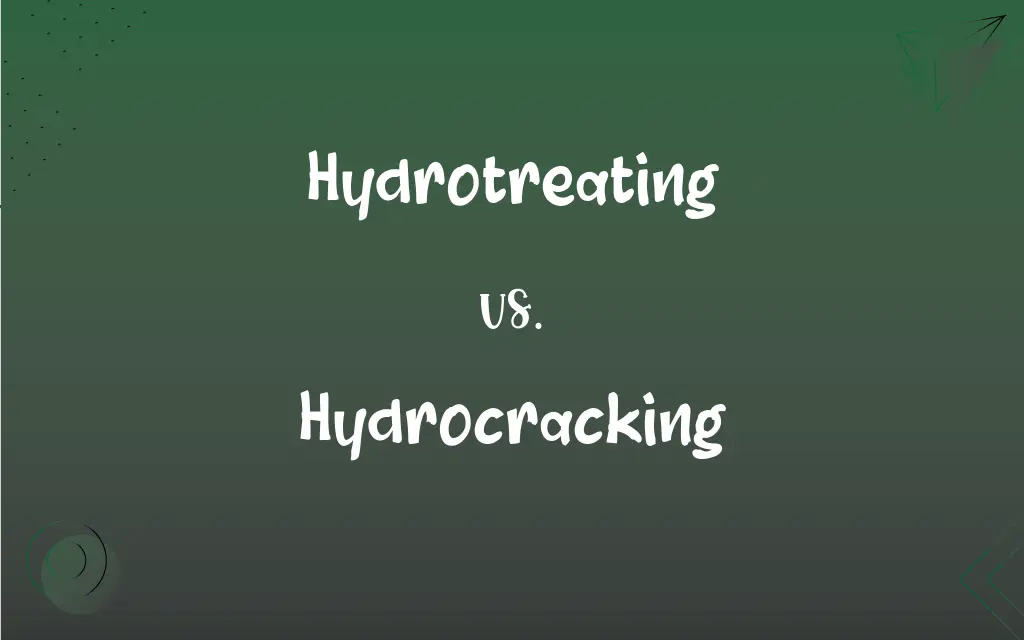Hydrotreating vs. Hydrocracking: What's the Difference?
Edited by Aimie Carlson || By Harlon Moss || Updated on November 7, 2023
Hydrotreating is a chemical process that removes impurities from petroleum fractions, while hydrocracking breaks down larger molecules into smaller ones, using hydrogen.

Key Differences
Hydrotreating and hydrocracking are both refining processes used in the petroleum industry to improve the quality of crude oil derivatives, but they serve different purposes and operate under different conditions. Hydrotreating is a chemical process that removes sulfur, nitrogen, and other contaminants from petroleum products by reacting them with hydrogen at high temperatures and pressures. Hydrocracking, on the other hand, not only removes impurities but also breaks down larger hydrocarbon molecules into smaller, more valuable ones like gasoline and diesel, through a reaction with hydrogen under even higher pressures and temperatures.
Hydrotreating is primarily a purification process, focusing on the removal of impurities that can be harmful to the environment when burned, such as sulfur in diesel fuel. This process helps in meeting regulatory standards for fuel emissions. Hydrocracking goes a step further by also cracking heavy hydrocarbon molecules into lighter, more useful fractions. While hydrotreating enhances the quality of the fuel, hydrocracking increases the yield of valuable products from crude oil.
The catalysts used in hydrotreating and hydrocracking also differ due to the nature of reactions they facilitate. Hydrotreating catalysts are designed to promote the removal of impurities without altering the size of the hydrocarbon molecules significantly. In contrast, hydrocracking catalysts need to be more robust to handle the breaking of carbon-carbon bonds, which requires more substantial chemical changes to the feedstock.
In terms of the final products, hydrotreating generally leaves the size and structure of the hydrocarbon chains largely intact, simply removing unwanted elements and saturating molecules with hydrogen to stabilize them. Hydrocracking, however, changes the fundamental structure of the feedstock, creating smaller chains that are in higher demand for consumer and industrial uses, such as jet fuel, liquefied petroleum gas (LPG), and naphtha, which are more versatile and valuable in the energy market.
While both processes use hydrogen, the amount and the conditions under which they operate are different. Hydrotreating uses less hydrogen and operates at lower temperatures and pressures compared to hydrocracking. Hydrocracking's more intense conditions not only remove impurities but also are necessary to break the molecular bonds, hence the "cracking" in its name. Despite these differences, both processes are integral to modern refining operations, improving the quality and usability of crude oil in environmentally friendly and economically beneficial ways.
ADVERTISEMENT
Comparison Chart
Primary Purpose
Removal of impurities from oil fractions
Breaking down large hydrocarbon molecules
Temperature and Pressure
Lower temperature and pressure
Higher temperature and pressure
Hydrogen Consumption
Less, primarily for impurity removal
More, used in breaking molecular bonds
Product Outcome
Cleaner fuel, but similar molecular size
Lighter, smaller hydrocarbon products
Catalysts
Designed for desulfurization and denitrogenation
Designed for cracking as well as impurity removal
ADVERTISEMENT
Hydrotreating and Hydrocracking Definitions
Hydrotreating
A refining process to remove sulfur and nitrogen from petroleum products.
Hydrotreating diesel fuel reduces its sulfur content.
Hydrocracking
A refining process that breaks down heavy hydrocarbons into lighter fractions.
Hydrocracking is used to increase gasoline production.
Hydrotreating
A treatment method using hydrogen to clean hydrocarbons.
Hydrotreating is essential for meeting environmental fuel standards.
Hydrocracking
A petroleum refining technique that involves a chemical reaction with hydrogen.
The hydrocracking unit is critical for the refinery’s output.
Hydrotreating
A chemical process to purify and enhance the quality of crude oil.
The refinery invested in better hydrotreating equipment.
Hydrocracking
A method for transforming less valuable heavy petroleum cuts into lighter products.
They updated their hydrocracking process to meet demand for jet fuel.
Hydrotreating
The process of adding hydrogen to organic molecules.
Hydrotreating helps in stabilizing the crude oil before transportation.
Hydrocracking
The process of converting heavy oils into lighter, more valuable products.
Hydrocracking improves the yield of kerosene from crude oil.
Hydrotreating
A step in refining that precedes other processes like hydrocracking.
After hydrotreating, the oil is ready for further refining.
Hydrocracking
A high-pressure, high-temperature refining process using hydrogen.
The refinery’s hydrocracking capabilities have increased its efficiency.
Hydrotreating
Present participle of hydrotreat
Hydrocracking
A process by which the hydrocarbon molecules of petroleum are broken into simpler molecules, as of gasoline or kerosene, by the addition of hydrogen under high pressure and in the presence of a catalyst.
Hydrotreating
(chemistry) A chemical engineering process in which reaction with hydrogen is used to remove impurities, especially as part of oil refining
Hydrocracking
(organic chemistry) the production of high-octane petroleum fuel and kerosene by hydrogenating large or complex hydrocarbons and then cracking them.
Hydrocracking
Present participle of hydrocrack
Hydrocracking
The process whereby hydrocarbon molecules of petroleum are broken down into kerosene and gasolene by the addition of hydrogen under high pressure in the presence of a catalyst
FAQs
Can hydrocracking change the quality of fuel?
Yes, it improves the quality by creating lighter, cleaner-burning fuels.
Why is hydrocracking important in refining?
Hydrocracking increases the quantity of lighter, more valuable petroleum products.
What is the goal of hydrotreating?
The goal is to remove impurities like sulfur and nitrogen from oil fractions.
What substances does hydrotreating target for removal?
It targets contaminants including sulfur, nitrogen, oxygen, and metals.
How does hydrotreating affect the environment?
It produces cleaner fuels that release fewer pollutants when burned.
Does hydrocracking use a specific type of catalyst?
Yes, hydrocracking uses a catalyst that can withstand high pressure and facilitate cracking.
Is hydrotreating necessary for all crude oils?
Most crude oils undergo hydrotreating to some degree to meet quality specifications.
Are hydrotreating and hydrocracking performed in sequence?
Often they are, with hydrotreating typically preceding hydrocracking.
What is the main chemical used in both hydrotreating and hydrocracking?
Hydrogen is the main chemical used in both processes.
Are hydrocracking units common in all refineries?
Not all, as some refineries may not require or have the capability for hydrocracking.
What products result from hydrocracking?
Gasoline, diesel, jet fuel, and other lighter hydrocarbons are typical products.
Can hydrocracking break down renewable or bio-based oils?
Yes, it's being adapted for use with renewable feedstocks as well.
How has hydrotreating evolved over the years?
It has advanced with better catalysts and processes to remove even lower levels of impurities.
What happens to the sulfur removed during hydrotreating?
It's often converted to elemental sulfur or sulfuric acid as a byproduct.
What are the byproducts of hydrotreating?
Besides cleaner oil, byproducts can include small amounts of gas and sometimes hydrogen sulfide.
How do refineries manage the hydrogen used in hydrocracking?
They typically have a hydrogen plant on-site or source it externally.
Can hydrocracking help in producing synthetic lubricants?
Yes, hydrocracking can produce base stocks for high-quality synthetic lubricants.
Does hydrotreating improve fuel efficiency?
By removing impurities, it can enhance combustion and potentially improve fuel efficiency.
Is hydrotreating alone enough to make crude oil into gasoline?
No, further refining steps like hydrocracking or reforming are needed to produce gasoline.
What determines the choice between hydrotreating and hydrocracking?
The desired product slate, quality specifications, and crude oil properties influence the choice.
About Author
Written by
Harlon MossHarlon is a seasoned quality moderator and accomplished content writer for Difference Wiki. An alumnus of the prestigious University of California, he earned his degree in Computer Science. Leveraging his academic background, Harlon brings a meticulous and informed perspective to his work, ensuring content accuracy and excellence.
Edited by
Aimie CarlsonAimie Carlson, holding a master's degree in English literature, is a fervent English language enthusiast. She lends her writing talents to Difference Wiki, a prominent website that specializes in comparisons, offering readers insightful analyses that both captivate and inform.































































